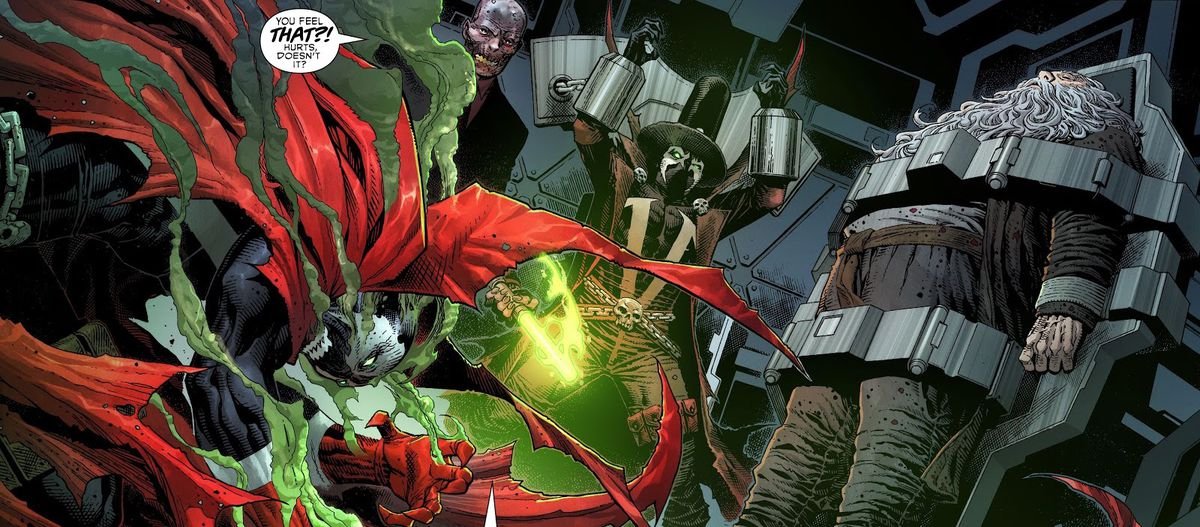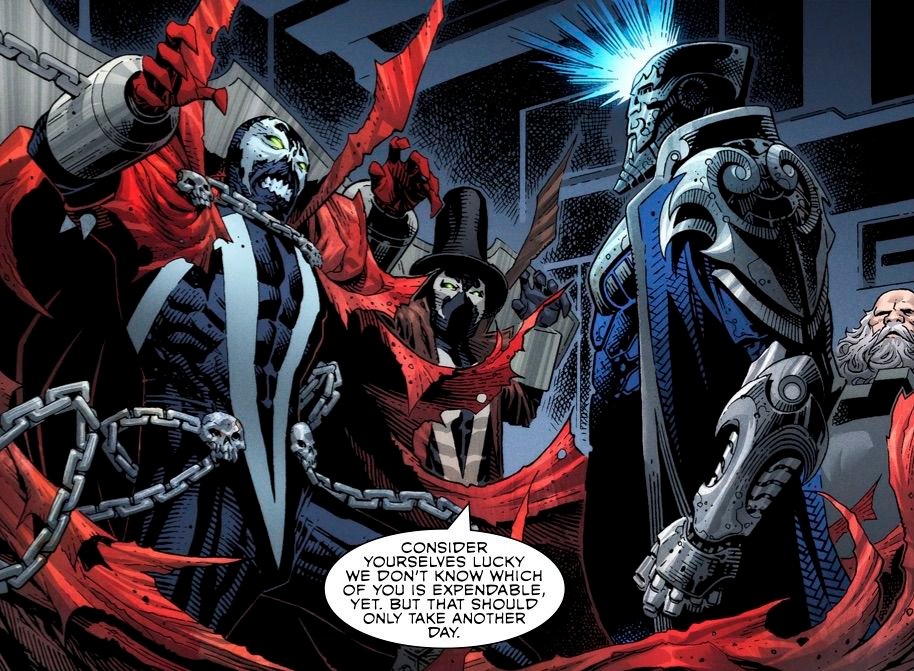When it first debuted in 1992, Todd McFarlane’s Spawn defined not only an entire publisher in the short term — it was the second-ever Image Comics series, and for a time, the company’s flagship book — but also an entire generational aesthetic for the superhero genre. What could be more 1990s than Spawn, a character overly accessorized with chains, an otherworldly oversized cape, and spiked gauntlets?
Spawn has held its own across the last three decades — the original title is now the longest-running creator-owned comic in the U.S. industry, having passed previous record holder Cerebus a couple of years ago — but it’s no longer the Next Big Thing. As pop culture continues to be held enraptured by Marvel and other “shared universes” of superheroes, McFarlane has decided that it’s time to build a new one around his signature character.
Hence: Spawn’s Universe, a one-shot launching three new monthly comics. The question is: Is it a universe that can interest fans who haven’t been reading for the last 29?
Who is making Spawn’s Universe #1?
It only makes sense that Spawn creator Todd McFarlane would write this ambitious franchise expansion, but the art line-up is arguably the true draw for non-Spawn fans this time around: Jim Cheung (Young Avengers, Justice League) draws the main story, with back-up previews for future titles in the line drawn by Brett Booth, Stephen Segovia, and Marcio Takara. (McFarlane does ink the Booth pages, for fans of his hyper-detailed style.)
What is Spawn’s Universe #1 about?
That’s a pretty good question. Spawn is — for reasons that presumably make sense to those who’ve been following the character for awhile — trying to get involved in a fight between Heaven and Hell that leads him back to the island of someone called Omega Spawn, where he runs into a new armored villain (the Disruptor, who maybe moonlights as a tech industry executive in his spare time judging by that name) as well as another Spawn altogether, called Gunslinger Spawn; this one wears a hat.

Image: Todd McFarlane, Jim Cheung/Image Comics
The two escape captivity somehow, but a third prisoner of the Disruptor, Cogliostro — who looks like Santa Claus if he’d hit a few rough years. He goes his own way: After being thrown into a well, he shaves and then flies out from under the sea, killing the crew of an unsuspecting boat in the process, while the caption declares, “The name Cogliostro dies tonight, instead, from this moment forward… the world, the entire universe will simply call him… ‘Sinn!’ This is just the beginning!”
There are also three back-ups, where different Spawns — Medieval, She-Spawn, and the Gunslinger — have a few pages to let you know that something bad is coming, even if it’s entirely unclear what that might be.
What is Spawn’s Universe #1 about? It’s about 64 pages.
Why is Spawn’s Universe #1 happening now?
If McFarlane’s editorial in the back of the book is to be believed, the issue is the start of a “multi-year effort… to bring high quality comics, with as many talented creators as possible, at the lowest price I can deliver.” In interviews, he’s talked about wanting to build off the sales success of 2019’s Spawn #300, but it can’t really be ignored that having a shared universe of properties ready to go will help McFarlane’s long-held ambitions to reboot Spawn as a major movie franchise. Well, assuming that moviegoing audiences want to see Spawn: Spawn in a Hat But This One is a Cowboy, I Think.
Is there any required reading?
Here’s where one of the major problems with Spawn’s Universe comes in. In theory, this issue should be the ideal jumping-on point for new readers, because that’s exactly what it’s meant to be. In practice, though, it’s filled with a number of specific references to specific issues — in addition to the undefined references to earlier stories that exist in the place of actually introducing characters or explaining contexts — that make the story almost unreadable. Anyone heading into this without having read Spawn #300 through #318, expect to be confused.
Oh, and #318, it turns out, is literally required reading, as it’s actually the start of the storyline that continues in this issue. You’d think that would be something noted in the “Previously in Spawn” caption on the inside cover, but that just says, “Three hundred and eighteen issues have led to this, the founding of Spawn’s Universe.” It’s true, just not particularly helpful.
Is Spawn’s Universe #1 good?

Image: Todd McFarlane, Jim Cheung/Image Comics
It would be easy to dismiss Spawn’s Universe #1 by saying that it’s probably a great comic for Spawn fans. Don’t get me wrong, it most likely is; it certainly feels like a comic that couldn’t be any more Spawn if it tried — again, there are four different Spawns in this issue, one of whom wears a hat. That’s not what Spawn’s Universe #1 should be, though — it’s a first issue intended to grow the fanbase, and in that respect, it’s a disaster.
It’s not just that the lack of explanations or context make things hard to care about, although that’s definitely true; McFarlane’s writing, at times so verbose that it feels like a parody of Chris Claremont’s X-Men in its prime (One word balloon boasts 62 words; there are three other balloons in the same panel, which is one of five on the page), veers between overly casual and overly excited, rarely landing anywhere in the middle, with dialogue that’s heavy on exposition for developments that barely make any sense. The comic isn’t confusing, per se; it’s just weightless and difficult to really care about, because the reader is never given any reason to.
It is, however, a very good looking comic, with all artists delivering great looking work — even Booth, whose work when inked by McFarlane becomes scratchier and more textured than what he’s been putting out at DC and Marvel over the last few years. In that respect, Spawn’s Universe #1 stays true to the Spawn appeal of old: it’s a book that you’d pick up to look at, with the writing a distant second in terms of appeal.
One panel that popped

Image: Todd McFarlane, Jim Cheung/Image Comics
That’s a lot of Spawns.
























































